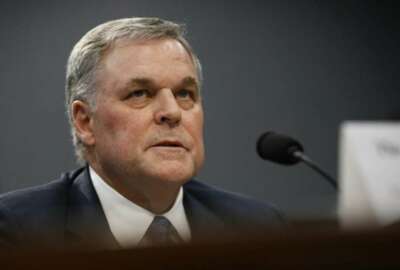
Hubbard Radio Washington DC, LLC. All rights reserved. This website is not intended for users located within the European Economic Area.
Hubbard Radio Washington DC, LLC. All rights reserved. This website is not intended for users located within the European Economic Area.
Somebody has to organize all of the considerations and best practices for reopening agencies -- the Government Accountability Office.
Best listening experience is on Chrome, Firefox or Safari. Subscribe to Federal Drive’s daily audio interviews on Apple Podcasts or PodcastOne.
You might say efforts to reopen federal buildings and offices has been, shall we say, problematic? Uneven? Uncertain? Well somebody had to organize all of the considerations and best practices for getting back to the sanitized water cooler and wiped-down communal coffee pot — the Government Accountability Office. With highlights, managing director for strategic issues Chris Mihm joined Federal Drive with Tom Temin.
Interview transcript:
Tom Temin: Chris, top line, what should agencies be doing right now that so many places are in phase two, yet other places are moving back to phase one? It’s kind of a mixed bag out there geographically.
Chris Mihm: It’s a pleasure to be with you again, Tom.vI guess the top line issue here is that agencies need to be looking at a very local level at the science in determining their reentry decisions based on that. There needs to be continuous two way communication with their employees, both in which the agency is telling the employees and keeping them informed about what’s happening and why, but also listening to employee concerns. This is the two way aspect, and taking those into its plans for re entry as well. So it’s local science driving reentry decisions and listening to employees and communicating with employees. That’s the key in our view.
Tom Temin: And what’s the best source of local science? I mean, by that you mean data on infection rates and the trends and that kind of thing? I mean, is there something besides the Johns Hopkins site, or maybe that is the best place?
Chris Mihm: It’s certainly a variety of sources. And it’s certainly in our own case at GAO, what we’re looking at. Obviously, you know, authoritative sources, the Centers for Disease Control, local public health authorities, Johns Hopkins, and others. Also they need to collaborate and coordinate information with other federal agencies that are located in the same area just to make sure first, that we’re not duplicating effort, but second, to make sure that we’re working off of a same set of facts, the same set of data as agencies that are located in a common area are making their own re entry decisions.
Tom Temin: And that gets to the issue of communications. There has to be some regularity but also some consistency and what employees are hearing. And I guess if say two agencies occupy the same building as they do in so many different areas of the country, if one agency is communicating one thing on floor three east, and they’re hearing something else on an agency on floor three west, that could be a problem.
Chris Mihm: Oh absolutely. And then that could be a huge concern. I mean, it’s things as simple as what are our masking protocols? Things as simple as have your temperature taken when you come into work. Do you ask employees to please take your temperature before you come into work at home? Do you say hey if you’re feeling sick, you know, then you may want to take your temperature. All of those can lead to real differences in how employees approach work, how work approaches the employees, and people reasonably want consistency, or at least when there’s differences among agencies, having confidence that those are differences based on considerations of agency mission and programs rather than just people making decisions differently just because different people were involved.
Tom Temin: Yes so it seems like it’s both something that should be driven by some kind of coherent central policy, but also federated to the local circumstances — and that’s not an easy order to fulfill on something as big as the government.
Chris Mihm: It’s not, but you’re exactly right. I mean there has to be both a top down and radically bottom up approach on this. And striking the right balance is never easy on this. But government has done this many times before, whether it be in disaster planning or in other matters. We need to have shared communication and shared sense of guidance and perspective that comes from the general federal level, while understanding that there may be differences, or rather there will be differences in how it looks and how it gets implemented down at the local level. And there needs to be information sharing that takes place not just at the local level, but also at the headquarters level and across government so that we can all know what types of decisions are being made based on what science and make sure that employees are being involved and informed.
Tom Temin: And then there are some hard logistics issues too, like I’ve heard from different agencies that one can call up Granger and one of these supply companies and fill their coffers with masks and sanitizer, and others, somehow the procurement regulations seem to get in the way and they can’t get the same stuff from the same supplier. How is that all going and what’s your best advice there?
Chris Mihm: The aspect that we talked about and have been tracking most closely is the Census Bureau as they reentry or reopen for large field operations, they have made sure that their employees will have the masks, have the hand sanitizers, have all the various PPE that they needed, and they did a huge procurement on that and the delivery has actually been coming in waves. And to get to your point, it’s not as though that everything is going to be available right away, but they were making sure that they the Census Bureau were making sure that they would have all the material they would need as they begin to follow up on the 50 to 60 million households that haven’t responded to the census.
Tom Temin: And on the presumption that there is going to be a pretty good level of teleworking from now on, not everybody, but maybe a certain percentage for a variety of reasons. And that also masks will become part of the workplace in the public sphere for the foreseeable future. Do you recommend that agencies maybe supply those disposable masks? And the reason I asked that is, if someone uses the same owned mask day after day, they could be walking in with a bacteria soaked piece of thing across their face, as opposed to just getting a brand new one and throwing it out when they leave.
Chris Mihm: That’s certainly one of the decisions that agencies need to make. And when we talk about the importance of coordination down at a local level, that’s exactly one of those issues that we wouldn’t want one agency where you’re mentioning kind of floor three and floor three west, where you have one agency that is making sure that there are people all have the mask, another agency saying well you’re on your own, we would really recommend that you occasionally change your mess. Those different decisions lead to confusion, lead to understandable anxiety among employees that we shouldn’t have those differences. Those are the types of things that agencies can work out ahead of time so working together they have a common message and common approach.
Tom Temin: Alright, and any other key practices to use a good GAO phrase?
Chris Mihm: Well, I think one of the things in searching for silver linings and in very dark times is that for many agencies, they have found that telework works. And as we go forward, what we’re urging them to do is look at the lessons learned positive and if itvhasn’t been seamless to look at the problems that they’ve had as an opportunity to expand telework and to keep telework in place as we get back to whatever normal will look like in a COVID world.
Tom Temin: Got it. And just out of curiosity, what about GAO itself? What does it look like for your office reopening plans? I mean, it’s pretty centralized, but it seems like a lot of people are still teleworking.
Chris Mihm: Yeah, we’re all teleworking and for us we were very fortunate that we were pretty much a high telework agency ahead of time and we have a field structure, 11 field offices, and I know when I called my colleagues, this is months ago, when I would call my colleagues to talk to them in a field office, I wouldn’t know where they were physically sitting at that moment, whether they were in an office or teleworking at home. And frankly, I don’t care, because they’re they’re doing the work and fulfilling the mission. And so for us, I would expect that it would be months rather than weeks before we’re back to any sort of re entry. I keep using the term reentry because we never closed and like a lot of the rest of the federal government, we’ve kept working and kept doing our reports on behalf of the Congress.
Tom Temin: And finally, the agencies did do a lot of effort, those that didn’t have a robust telework and remote access technology structure in place before all of this, now that they have it, is there any backfilling and standardization or any kind of efforts they have to do to keep this capability going at some reasonable cost and reasonable way to manage?
Chris Mihm: That’s one of the things that we urge agencies to do now is to do an assessment of how their telework is working. Did they have the technology in place that can withstand peak usage from people, from their employees during the day? Did they have the bandwidth that would would do that? Do they haven’t placed the right set of personnel practices and policies? So this is all part of the evaluation that agency should be doing with an eye towards both lessons learned in the immediate crisis, but also, what can we do, what does this tell us about the opportunities for telework going forward?
Tom Temin: Chris Mihm is managing director for strategic issues at the Government Accountability Office. As always, thanks so much.
Chris Mihm: My great pleasure.
Copyright © 2024 Federal News Network. All rights reserved. This website is not intended for users located within the European Economic Area.
Tom Temin is host of the Federal Drive and has been providing insight on federal technology and management issues for more than 30 years.
Follow @tteminWFED

